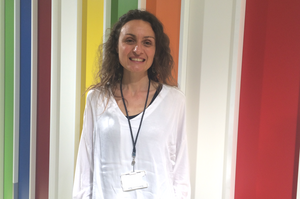“The discovery of GDF15 overexpression in patients with mitochondrial disease opened a door towards an improvement in their diagnosis”
Currently we work, basically, in two big areas: congenital muscular dystrophies (CMD) and mitochondrial diseases. Children with CMD are born with muscular weakness or they develop it during the first year of life. One of the most common forms is Ullrich Congenital Muscular Dystrophy. Mitochondrial diseases can affect multiple organs, generally those requiring a higher amount of energy, such as the muscles, brain and liver, which are the ones more dependent on mitochondrial function.
Which was the aim to create the neuromuscular diseases laboratory?
When I arrived at the HSJD 6 years ago, I started the research laboratory with the aim to study the mechanisms causing the neuromuscular diseases. For that, we decided to implement many “OMIC” techniques that allowed us to obtain an overview of the disease; as if it was an aerial photograph of one village, with the framework of all the streets and avenues.
Which information could you extract from this signaling pathways’ map?
One of the most difficult things when working on neuromuscular diseases is the lack of information we have. Thanks to this map, we could know better the disease process, which were the altered functions in the affected muscular cells and compare the expression of genes between affected and healthy children. Our aim was to identify possible biomarkers for the diagnosis, as it is quite complex in these diseases, and identify therapeutic targets, as it does not exist any treatment.
And the result led you to the discovery of the overexpression of the GDF15 molecule in the affected?
Exactly, as the result of a study that we published in 2014, we identified the overexpression of the GDF15 (Growth and Differentiation Factor 15) gene in the muscle of the patients. Until that date, this molecule was been related to other diseases, but we were the firsts to associate it with mitochondrial diseases.
Which relation exists between the GDF15, patients with mitochondrial diseases and the mitochondrial damage?
A collaborative study between the Biochemistry laboratory (from which Dr. Artuch and Dr. Montero were the collaborators), the group directed by Dr. Villarroya (from the University of Barcelona) and our laboratory, allowed us to corroborate that a in a large group of patients, the GDF15 was highly elevated in serum compared to healthy individuals. Thus, this molecule could be used as a biomarker for this disease. Even more, the sensitivity and specificity of GDF15 is higher than for other markers. The use of this molecule together with other clinical, biochemical and pathological criteria allowed a significant improvement in the diagnosis of this group of patients.
Furthermore, we complemented this study in collaboration with Dr. Villarroya group, which demonstrated a relation between GDF15 and mitochondrial damage in muscular cells.

